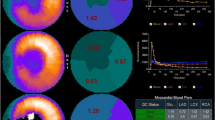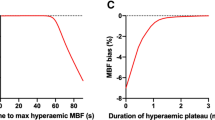Abstract
Background
Mechanistic differences between pharmacologic stressors may offer different clinical benefits. Therefore the effects of dobutamine and adenosine on absolute myocardial blood flow (MBF) and coronary flow reserve (CFR) were compared.
Methods and Results
We divided 36 patients (mean age, 61 ± 8 years) with coronary artery disease into 2 groups based on stenosis severity as follows: greater than 50% but less than 75% (n = 16) and greater than 75% (n = 20). In addition, 18 normal volunteers (mean age, 46 ± 7 years) served as control subjects. Groups of equal sizes received either dobutamine or adenosine. MBF at rest and peak MBF were measured by use of positron emission tomography in territories subtended by the stenosis (ischemic) and remote myocardium (remote), whereas left ventricular MBF was used in control subjects. CFR was calculated as peak MBF divided by MBF at rest. CFR was significantly greater with adenosine than with dobutamine stress in control subjects and remote CFR. Ischemic CFR was blunted to a similar degree with each stressor. Therefore adenosine achieved flow heterogeneity across all coronary stenosis severities greater than 50%. However, dobutamine achieved flow heterogeneity only in the presence of a severe coronary stenosis greater than 75% despite provoking a greater ischemic stimulus.
Conclusion
Adenosine stress demonstrated a higher sensitivity and dobutamine demonstrated a higher specificity with quantitative perfusion imaging. Therefore adenosine is superior for diagnostic perfusion imaging, whereas dobutamine is better suited in combination with visual imaging and in the functional assessment of a known coronary stenosis. (J Nucl Cardiol 2006;13:324-32.)
Similar content being viewed by others
References
Fragasso G, Lu C, Dabrowski P, Pagnotta P, Sheiban I, Chierchia SL. Comparison of stress/rest myocardial perfusion tomography, dipyridamole and dobutamine stress echocardiography for the detection of coronary disease in hypertensive patients with chest pain and positive exercise test. J Am Coll Cardiol 1999;34:441–7.
Marwick T, Willemart B, D’Hondt AM, Baudhuin T, Wijns W, Detry JM, et al. Selection of the optimal nonexercise stress for the evaluation of ischemic regional myocardial dysfunction and malperfusion. Comparison of dobutamine and adenosine using echocardiography and 99mTc-MIBI single photon emission computed tomography. Circulation 1993;87:345–54.
Nagaoka H, Isobe N, Kubota S, Iizuka T, Imai S, Suzuki T, et al. Comparison of adenosine, dobutamine, and exercise radionuclide ventriculography in the detection of coronary artery disease. Cardiology 1997;88:180–8.
Bartunek J, Wijns W, Heyndrickx GR, de Bruyne B. Effects of dobutamine on coronary stenosis physiology and morphology: comparison with intracoronary adenosine. Circulation 1999; 100: 243–9.
Bin JP, Pelberg RA, Wei K, Le DE, Goodman NC, Kaul S. Dobutamine versus dipyridamole for inducing reversible perfusion defects in chronic multivessel coronary artery stenosis. J Am Coll Cardiol 2002;40:167–74.
Bin JP, Le DE, Jayaweera AR, Coggins MP, Wei K, Kaul S. Direct effects of dobutamine on the coronary microcirculation: comparison with adenosine using myocardial contrast echocardiography. J Am Soc Echocardiogr 2003;16:871–9.
Paetsch I, Jahnke C, Wahl A, Gebker R, Neuss M, Fleck E, et al. Comparison of dobutamine stress magnetic resonance, adenosine stress magnetic resonance, and adenosine stress magnetic resonance perfusion. Circulation 2004;110:835–42.
de Silva R, Camici PG. Role of positron emission tomography in the investigation of human coronary circulatory function. Cardiovasc Res 1994;28:1595–612.
Skopicki HA, Abraham SA, Picard MH, Alpert NM, Fischman AJ, Gewirtz H. Effects of dobutamine at maximally tolerated dose on myocardial blood flow in humans with ischemic heart disease. Circulation 1997;96:3346–52.
Uren NG, Melin JA, de Bruyne B, Wijns W, Baudhuin T, Camici PG. Relation between myocardial blood flow and the severity of coronary-artery stenosis. N Engl J Med 1994;330:1782–8.
Krivokapich J, Huang SC, Schelbert HR. Assessment of the effects of dobutamine on myocardial blood flow and oxidative metabolism in normal human subjects using nitrogen-13 ammonia and carbon-11 acetate. Am J Cardiol 1993;71:1351–6.
Severi S, Underwood R, Mohiaddin RH, Boyd H, Patemi M, Camici PG. Dobutamine stress: effects on regional myocardial blood flow and wall motion. J Am Coll Cardiol 1995;26:1187–95.
Diamond GA, Forrester JS. Analysis of probability as an aid in the clinical diagnosis of coronary-artery disease. N Engl J Med 1979; 300:1350–8.
Shepherd J, Cobbe SM, Ford I, Isles CG, Lorimer AR, MacFarlane PW, et al. Prevention of coronary heart disease with pravastatin in men with hypercholesterolemia. West of Scotland Coronary Prevention Study Group. N Engl J Med 1995;333:1301–7.
Cerqueira MD, Verani MS, Schwaiger M, Heo J, Iskandrian AS. Safety profile of adenosine stress perfusion imaging: results from the Adenoscan Multicenter Trial Registry. J Am Coll Cardiol 1994;23:384–9.
Hermansen F, Ashbumer J, Spinks TJ, Kooner JS, Camici PG, Lammertsma AA. Generation of myocardial factor images directly from the dynamic oxygen-15-water scan without use of an oxygen- 15-carbon monoxide blood-pool scan. J Nucl Med 1998;39:1696–702.
Hermansen F, Rosen SD, Fath-Ordoubadi F, Kooner JS, Clark JC, Camici PG, et al. Measurement of myocardial blood flow with oxygen-15 labelled water: comparison of different administration protocols. Eur J Nucl Med 1998;25:751–9.
Hermansen F, Bloomfield PM, Ashbumer J, Camici PG, Lammertsma AA. Linear dimension reduction of sequences of medical images: II. Direct sum decomposition. Phys Med Biol 1995;40: 1921–41.
Hermansen F, Lammertsma AA. Linear dimension reduction of sequences of medical images: III. Factor analysis in signal space. Phys Med Biol 1996;41:1469–81.
Schiller NB, Shah PM, Crawford M, DeMaria A, Devereux R, Feigenbaum H, et al. Recommendations for quantitation of the left ventricle by two-dimensional echocardiography. American Society of Echocardiography Committee on Standards, Subcommittee on Quantitation of Two-Dimensional Echocardiograms. J Am Soc Echocardiogr 1989;2:358–67.
Camici P, Marraccini P, Marzilli M, Lorenzoni R, Buzzigoli G, Puntoni R, et al. Coronary hemodynamics and myocardial metabolism during and after pacing stress in normal humans. Am J Physiol 1989;257:E309–17.
Jagathesan R, Kaufmann PA, Rosen SD, Rimoldi OE, Turkeimer F, Foale R, et al. Assessment of the long-term reproducibility of baseline and dobutamine-induced myocardial blood flow in patients with stable coronary artery disease. J Nucl Med 2005; 46:212–9.
Kaufmann PA, Gnecchi-Ruscone T, Yap JT, Rimoldi O, Camici PG. Assessment of the reproducibility of baseline and hyperemic myocardial blood flow measurements with 150-labeled water and PET. J Nucl Med 1999;40:1848–56.
Krivokapich J, Smith GT, Huang SC, Hoffman EJ, Ratib O, Phelps ME, et al. 13N ammonia myocardial imaging at rest and with exercise in normal volunteers. Quantification of absolute myocardial perfusion with dynamic positron emission tomography. Circulation 1989;80:1328–37.
Krivokapich J, Czemin J, Schelbert HR. Dobutamine positron emission tomography: absolute quantitation of rest and dobutamine myocardial blood flow and correlation with cardiac work and percent diameter stenosis in patients with and without coronary artery disease. J Am Coll Cardiol 1996;28:565–72.
Kim C, Kwok YS, Heagerty P, Redberg R. Pharmacologic stress testing for coronary disease diagnosis: a meta-analysis. Am Heart J 2001;142:934–44.
Iskandrian AS, Verani MS, Heo J. Pharmacologie stress testing: mechanism of action, hemodynamic responses, and results in detection of coronary artery disease. J Nucl Cardiol 1994;1:94–111.
Tadamura E, Iida H, Matsumoto K, Mamede M, Kubo S, Toyoda H, et al. Comparison of myocardial blood flow during dobutamine-atropine infusion with that after dipyridamole administration in normal men. J Am Coll Cardiol 2001;37:130–6.
Leong-Poi H, Rim SJ, Le DE, Fisher NG, Wei K, Kaul S. Perfusion versus function: the ischémie cascade in demand ischemia: implications of single-vessel versus multivessel stenosis. Circulation 2002;105:987–92.
Imran MB, Palinkas A, Picano E. Head-to-head comparison of dipyridamole echocardiography and stress perfusion scintigraphy for the detection of coronary artery disease: a meta-analysis. Comparison between stress echo and scintigraphy. Int J Cardiovasc Imaging 2003;19:23–8.
Martin TW, Seaworth JF, Johns JP, Pupa LE, Condos WR. Comparison of adenosine, dipyridamole, and dobutamine in stress echocardiography. Ann Intern Med 1992;116:190–6.
Uren NG, Camici PG, Melin JA, Bol A, de Bruyne B, Radvan J, et al. Effect of aging on myocardial perfusion reserve. J Nucl Med 1995;36:2032–6.
Czernin J, Muller P, Chan S, Brunken RC, Porenta G, Krivokapich J, et al. Influence of age and hemodynamics on myocardial blood flow and flow reserve. Circulation 1993;88:62–9.
Chareonthaitawee P, Kaufmann PA, Rimoldi O, Camici PG. Heterogeneity of resting and hyperemic myocardial blood flow in healthy humans. Cardiovasc Res 2001;50:151–61.
Chan SY, Brunken RC, Czemin J, Porenta G, Kuhle W, Krivokapich J, et al. Comparison of maximal myocardial blood flow during adenosine infusion with that of intravenous dipyridamole in normal men. J Am Coll Cardiol 1992;20:979–85.
Author information
Authors and Affiliations
Corresponding author
Rights and permissions
About this article
Cite this article
Jagathesan, R., Barnes, E., Rosen, S.D. et al. Comparison of myocardial blood flow and coronary flow reserve during dobutamine and adenosine stress: implications for pharmacologic stress testing in coronary artery disease. J Nucl Cardiol 13, 324–332 (2006). https://doi.org/10.1016/j.nuclcard.2006.03.017
Received:
Accepted:
Issue Date:
DOI: https://doi.org/10.1016/j.nuclcard.2006.03.017




